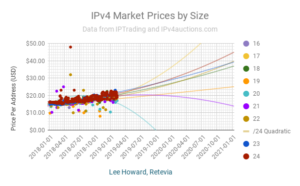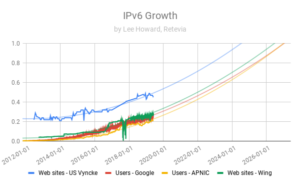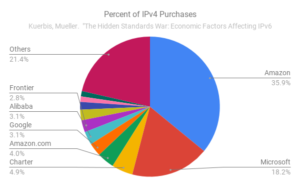Ten years ago, I gave a presentation on the Total Cost of Ownership of Carrier Grade NAT (TCO of CGN). I’ve revised that original TCO of CGN spreadsheet, and at NANOG 76 I revisited it in a presentation called “Prisoner of IPv4.” (slides, video)
Given certain assumptions about how bad CGN affects customers, it’s possible to conclude that it’s better to buy IPv4 addresses until the price exceeds $35. That day is coming. [1]

IPv6 growth is only slightly faster than IPv4 address prices. 
So what’s keeping people from deploying IPv6 already?
Some companies have not fully committed to IPv6, because they aren’t sure when everyone else will move. If you’re a network operator (ISP, mobile, enterprise) who thinks content won’t deploy IPv6, then you won’t deploy IPv6. If you’re a content operator (web site, CDN, host, cloud) who thinks network operators won’t deploy IPv6, you won’t deploy IPv6. In other words, everyone’s strategy depends on what they think everyone else’s strategy is.
That reminds me of The Prisoner’s Dilemma. In that dilemma, two prisoners are accused of a crime, and told that if they blame the other one, they’ll get a lesser sentence. If they both deny the crime, they get a one year sentence. If one blames the other, the rat goes free and the other gets three years in prison. If they blame each other, they each serve two years. If either prisoner knew what the other would do, they could maximize their benefit.
The Prisoner’s Dilemma is often represented with a Payoff Matrix, comparing the four possible permutations of Prisoner A and Prisoner B each keeping silent or each blaming the other. The values of the matrix are populated with the number of years in prison.
Can we figure out the penalties and payoffs of “Promote IPv6” and “Ignore IPv6” for content and carriers?
Carriers
Well, for carriers with a profit less than the price of an IPv4 address (and looking at the chart, $50 price for IPv4 is in view), you have a few choices:
- Raise prices. A 30% price hike on the cheapest tier probably loses that market.
- Require extended contracts. Five year commit to make sure it’s profitable may not work in a dynamic market.
- Address sharing (CGN). Might break some customer functions (see TCO of CGN above).
- Deploy IPv6. Recommended, but insufficient until everyone has it.
- Sell addresses. If customers aren’t profitable, stop signing them up, and sell addresses instead. One time revenue instead of recurring revenue.
- Combination of the above. Most likely.
Since IPv6 is already over 50% in the US and about 30% in the rest of the world (see chart above), IPv6 reduces the pressure proportionately, so the other options are less painful. Maybe put lower tier customers (who are less likely to have use cases that break) behind CGN.
How much does that strategy cost? Based on retail prices of CGN, $1000 per Gbps is a realistic retail price.[2] We also need IPv4 addresses for that CGN, which we can estimate at $50 each in the future, but how many do we need?
With 1 Gbps we can serve 200-1000 customers, according to a recent NANOG thread. Call it 400, since we’re looking into the future. But what’s the NAT compression ratio–how many users per address? Since mobile providers are already using NAT, I looked at some of them, and divided their subscriber count by the number of IPv4 addresses they announce, and found they were using 1-26 subscribers per address. Again, for the sake of easy predictions, let’s go low and choose a 10:1 compression ratio.
For every 1 Gbps of CGN, you have 400 broadband customers, and want 40 addresses (10 customers per address). At $50, that’s $2,000 in IPv4 addresses for every Gbps of CGN capacity. Add in a couple of dollars for systems development. Every year there’s some electricity, staff, development, capacity, and so on, so call it $2/year per user ($800/Gbps).
Therefore, CGN realistically costs $3,800 per Gbps ($1000 for hardware + $2000 for addresses + $800 for software). But please, do your own math.
Content Providers
What’s the payoff for each strategy for content providers?
We can see they’re nervous, with 134 million IPv4 addresses having been transferred, largely by content companies.

That indicates fear of IPv4 runout. Maybe they think they can buy addresses forever, and that carriers will spend money to deploy CGN.
But there’s some direct value to IPv6, too: IPv6 is faster. Typically 20ms faster. So what?
- Amazon says 100ms costs 1% of sales.
- Akamai reported that 100ms can hurt conversion rate by 7%.
- In one famous Google experiment, half a second delay caused a 20% drop in traffic.
- The BBC lost 10% of users for every 1s page load time.
- Pinterest increased sign-ups 15% with 40% lower wait.
- COOK conversions up 7% when page load time (PLT) down 850ms.
- DoubleClick 53% of mobile site visits bailed if PLT is more than 3s.
- Mobify found 100ms PLT = +1.11% conversion= $380,000.
Sales conversions correlate to speed. Ad revenue only comes in if the pages are viewed, which they aren’t with long page load times. Latency is a major contributor to PLT:
![]()
The median web page includes 70-75 total requests and over 150 at the 90th percentile. Typical web browsers open six concurrent sessions (waiting for each to complete before opening the next one). For a web site that’s 40ms away and takes 1 second to load, gaining 20ms saves 1/2 second.
Using their public statements above, and their public statements about revenues, we find:
- For Amazon, 20ms = 0.2% in sales = $400 million
- For Akamai, 20ms = 1.4% in sales = $38 million
- For Google, ½ sec = 20% in revenue = $1.1 billion
- and so on
So now we can populate our payoff matrix:
| Content Promotes IPv6 | Content Does Nothing | |
| Carriers Promote IPv6 |
|
|
| Carriers Do Nothing |
|
|
But please, do your own math.
Strategy
Content Strategy
If you were an executive at Amazon and understood that there was a $400 million opportunity, what would you do to maximize the odds of that opportunity?
- Dual-stack amazon.com. Using Amazon’s statements about the value of speed, the 28% of the world that has IPv6 would get a 0.2% sales boost, for $116 million in the first year. That’s a significant budget to justify the effort of dual-stack.
- Why does Amazon sell anything that prevents them from seeing that $400 million per year? Warn the consumer electronics manufacturers, and especially home gateway manufacturers: as of June 6, 2020, Amazon will no longer carry any device without an IPv6 certification. Can they stomach the risk? The US is already 50% IPv6; Amazon is 5% of US retail; therefore 2.5% of home gateways Amazon sells in the US would go to homes that didn’t already have IPv6. That 2.5% of homes would get IPv6, for a sales increase of 0.2% over Amazon’s North American sales, for $70M in the first year.[3] In the second year, those customers would still be buying, and more customers would be buying, for a cumulative benefit.
If you were an executive at Google and understood that there was a $1.1 billion opportunity, what would you do?
- Blog that IPv6=speed=higher search rankings.
- IPv6 in GCP by default.
- Google Shopping: promote devices with IPv6 certification
- Require all Android apps to support IPv6 by June 2020.
- Block Android apps in the Google Play Store that require IPv4
- All of the above
I looked at online sales numbers for WalMart.com, Macys.com, Staples.com, HomeDepot.com, bestBuy.com, Dell.com, and eBay.com. The eCommerce sites above typically reported a 1% boost in sales for the equivalent of a 20ms gain, so these sites would add $15M-$50M just by adding IPv6 to their sites.
I looked at sites that mostly sell advertising, including Twitter.com, Zillow.com, CBS.com, and using the 7% boost in view typical of ad sites above, found they would make and additional $20M-60M just by adding IPv6. Reddit.com, Twitch.tv, Yelp.com, and Buzzfeed.com are smaller, and the speed increase from IPv6 would be more like $2M-$6M for them.
If you’re a web site or content provider and want to know the value of promoting IPv6, we’ve created an online tool. It’s using static values for the percentage deployment of IPv6 in each region; we’ll get that updated.
Carrier Strategy
If you were an executive at an ISP, mobile carrier, or enterprise network who understood the costs of running out of IPv4 addresses before 2027 (see IPv6 Growth projections, top), what would you do?
You would deploy IPv6.
Then you would ask why all of your customers aren’t using IPv6, even though you’ve deployed it everywhere. To avoid $9.50 per customer, you would fund IPv6 Certification testing of home gateways. This might include testing MAP-T, MAP-E, and 464xlat.
You might then fund testing of other consumer electronics devices.
You would also look at your own business customers, and (with appropriate warning) you would enable IPv6 for all of them, making it easy for them to just turn on IPv6, if it isn’t on already. That would include responding to DHCPv6 requests, statically routing a /48 prefix to any customer with a static IPv4 address (followed by an email to the customer), and BGP routing a /48 to any BGP customers (followed by an email to the customer).
If you’re an ISP and want to know the value of partnering (as described above and in the presentation) with content to deploy IPv6, we’ve created an online tool.
Conclusion
With the value of IPv6 promotion shown here, it makes sense for each actor to undertake small projects to enable the success of the other actors.
- Carriers can help e-commerce sites by certifying IPv6 Ready home gateways.
- E-commerce sites can help carriers by carrying only those home gateways and certified electronics.
- Carriers can then add more IPv6 users, which increases sales at e-commerce sites.
- Carriers adding IPv6 users helps cloud providers and CDNs default to IPv6, which further enables e-commerce sites.
- Increased deployment of IPv6 by content providers, cloud providers, and CDNs then reduces the cost to carriers by requiring less capacity and fewer addresses on the CGN.
[1] A comment at the mike said $50 is a complete fantasy. I’m showing a chart, and considering what it might mean if that extrapolation happens. Don’t take my word for it: do your own math, and don’t invest money you can’t afford to lose, including your business.
[2] A comment at the mike said $1000/Gbps was much too high for CGN, but he was talking about Microtik and specific chips. While Microtik makes products that are good for many things, most people wouldn’t consider their gear “carrier grade.” It is possible to run NAT on commodity servers with open source software, but most people wouldn’t consider it carrier grade. If those options work for you, then by all means, substitute your own numbers and do the math your way.
[3] A comment on Twitter pointed out that 2.5% of Amazon sales doesn’t mean 2.5% of homes get new routers; it means that 2.5% of homes that get new routers get a new IPv6 capability. If 20% of routers are replaced each year, then 0.5% of homes would newly get IPv6. Sorry, this strategy is only worth $14 million per year, compounding.
NOTE: Lee Howard is now at IPv4.Global by Hilco Streambank.
3 thoughts on “Prisoner of IPv4”
Comments are closed.